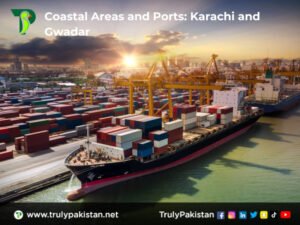Coastal Areas and Ports: Karachi and Gwadar
Coastal Regions and Ports:
Cultivating Economic Prosperity and Global Trade The inherent interdependence of economic well-being and international trade is vividly exemplified in Pakistan’s dynamic coastal cities of Karachi and Gwadar. Situated along the Arabian Sea, these strategically positioned urban hubs have been instrumental in shaping Pakistan’s maritime trade, propelling economic progress, and forging essential connections with the international community.
Within this extensive discourse, we will thoroughly explore the significance, infrastructure, and potential of Karachi and Gwadar ports, shedding light on their central roles in regional and global trade.
Karachi Port: The Economic Heartbeat
Historical Significance
Karachi is built on a coastal plain with scattered rocky outcroppings, hills, and coastal marshlands. Coastal mangrove forests grow in the brackish waters around the Karachi Harbour, and farther southeast towards the expansive Indus River Delta. Within the city of Karachi are two small ranges: the Khasa Hills and Mulri Hills, which lie in the northwest and act as a barrier between North Nazimabad Town and Orangi Town. Karachi’s hills are barren and are part of the larger Kirthar Range, and have a maximum elevation of 528 meters (1,732 feet)
Infrastructure and Capacity
Karachi Port boasts state-of-the-art infrastructure, including multiple terminals catering to various cargo types. The port handles a wide range of goods, from containers and bulk cargo to cars and oil. Its deep-water berths and modern container terminals allow the efficient handling of large vessels, making it a preferred choice for international shipping lines.
Economic Impact
The economic effect of Karachi Port is substantial. The Port of Pakistan assumes a pivotal role in the nation’s import and export activities, thus making a substantial contribution to its Gross Domestic Product (GDP). As a central hub in regional connectivity, the port accelerates trade with neighboring countries, most notably Afghanistan and the Central Asian states. Its pivotal role in regional commerce underscores its status as a significant contributor to the economic advancement of the area.

Gwadar Port: A Vital Gateway to the China-Pakistan Economic Corridor (CPEC)
Strategic Location
Gwadar Port, established as a deep-sea terminal on the southwestern coast of Pakistan within the province of Balochistan, has garnered international recognition owing to its strategic location at the junction of the Middle East, Central Asia, and South Asia Functioning as the southern endpoint of the China-Pakistan Economic Corridor (CPEC), this visionary infrastructure project is intended to establish a linkage between Gwadar and China’s western Xinjiang region.
Infrastructure Development
Gwadar Port is experiencing extensive infrastructure development, with plans to expand and modernize its facilities. The commencement of construction for deep-water berths, versatile cargo terminals, and associated road and rail networks is underway. These endeavors are geared towards elevating Gwadar’s capacity to accommodate a diverse spectrum of cargo, ranging from energy resources to consumer products.
Trade Potential
Gwadar Port’s ability to revolutionize regional trade cannot be overstated. It gives a shorter and more cost-effective trade route for China to access the Arabian Sea and beyond. Moreover, it furnishes landlocked Central Asian nations with crucial access to a warm-water port for both importing and exporting their commodities. As Gwadar Port continues to evolve and solidify its role within the global maritime network, it is on the verge of assuming a central position for trade and connectivity within the region.
Challenges and Prospects
Security Concerns
Both Karachi and Gwadar ports face security difficulties due to their strategic significance. Safeguarding the integrity and security of these critical trade gateways remains imperative for their sustained efficacy. Pakistan has implemented significant measures to fortify security in these regions, yet continuous vigilance is an ongoing requirement.
Infrastructure Investment
Investing in infrastructure is important to unleash the full potential of these ports. The growth and modernization of facilities, better connectivity through road and rail networks, and the development of special economic zones around the ports are all essential components of maximizing their effect.
Conclusion: A Tale of Two Ports
Karachi and Gwadar ports epitomize Pakistan’s maritime aspirations and its status as a central figure in regional and international commerce. While Karachi Port boasts a rich historical legacy and maintains its status as a thriving trade hub, Gwadar Port embodies the prospects of a new chapter in Pakistan’s maritime trade, carrying extensive implications for regional connectivity and economic advancement.
As these ports advance and broaden their horizons, they will not only serve as the impetus for Pakistan’s economic growth but also assume vital roles in nurturing economic relationships and connectivity across South Asia, the Middle East, and more distant regions. Collectively, Karachi and Gwadar ports function as cornerstones of advancement and affluence, benefitting both Pakistan and the wider regional context.

